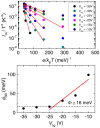Hall and field-effect mobilities in few layered p-WSe₂ field-effect transistors
- PMID: 25759288
- PMCID: PMC4355631
- DOI: 10.1038/srep08979
Hall and field-effect mobilities in few layered p-WSe₂ field-effect transistors
Abstract
Here, we present a temperature (T) dependent comparison between field-effect and Hall mobilities in field-effect transistors based on few-layered WSe2 exfoliated onto SiO2. Without dielectric engineering and beyond a T-dependent threshold gate-voltage, we observe maximum hole mobilities approaching 350 cm(2)/Vs at T = 300 K. The hole Hall mobility reaches a maximum value of 650 cm(2)/Vs as T is lowered below ~150 K, indicating that insofar WSe2-based field-effect transistors (FETs) display the largest Hall mobilities among the transition metal dichalcogenides. The gate capacitance, as extracted from the Hall-effect, reveals the presence of spurious charges in the channel, while the two-terminal sheet resistivity displays two-dimensional variable-range hopping behavior, indicating carrier localization induced by disorder at the interface between WSe2 and SiO2. We argue that improvements in the fabrication protocols as, for example, the use of a substrate free of dangling bonds are likely to produce WSe2-based FETs displaying higher room temperature mobilities, i.e. approaching those of p-doped Si, which would make it a suitable candidate for high performance opto-electronics.
Figures







References
-
- Wang Q. H., Kalantar-Zadeh K., Kis A., Coleman J. N. & Strano M. S. Electronics and Optoelectronics of Two-Dimensional Transition Metal Dichalcogenides. Nat. Nanotechnol. 7, 699 (2014). - PubMed
-
- Chhowalla M. et al. The Chemistry of Two-Dimensional Layered Transition Metal Dichalcogenide Nanosheets. Nat. Chem. 5, 263–275 (2013). - PubMed
-
- Zeng H. L., Dai J. F., Yao W., Xiao D. & Cui X. D. Valley Polarization in MoS2 Monolayers by Optical Pumping. Nat. Nanotechnol. 7, 490–493 (2012). - PubMed
-
- Mak K. F., He K. L., Shan J. & Heinz T. F. Control of Valley Polarization in Monolayer MoS2 by Optical Helicity. Nat. Nanotechnol. 7, 494–498 (2012). - PubMed
-
- Kim S. et al. High-Mobility and Low-Power Thin-Film Transistors Based on Multilayer MoS2 Crystals. Nat. Commun. 3, 1011 (2012). - PubMed
Publication types
LinkOut - more resources
Full Text Sources
Other Literature Sources

